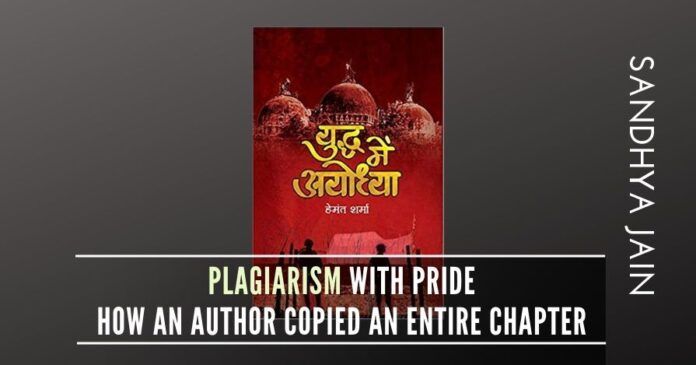
Sometime on November 1, 2018 it was brought to my notice that Anand Kumar, a market research consultant, had tweeted his review of journalist Hemant Sharma’s book, Yudh Mein Ayodhya, wherein Kumar asserted that one chapter, Sangharsh, appeared to be a verbatim translation of Dr. Meenakshi Jain’s Rama & Ayodhya (Aryan International Books, 2013).
Kumar, who posted his review at the Amazon website where Jain’s book is listed, added that the bibliography appeared to be a straight lift from Jain’s work, did not seem to have been read, and did not add to the references cited by Jain. Above all, Sharma does not cite or acknowledge Jain’s work, though it is the most exhaustive study of the Hindu struggle for reclamation of the Ram Janmabhumi at Ayodhya, traces the historicity of Rama through historical, literary and archaeological references, and clinically dissects the Allahabad High Court judgement of 2010.
[See
Besides being a formidable scholar, Meenakshi Jain is my sister, so I drew attention to this event on my own Twitter following, for the benefit of Meenakshi Jain’s admirers, as she is not on Twitter. This was picked up by my brother, Sunil Jain, who also tweeted the development.
Hemant Sharma, a former Director of News at Rajat Sharma’s India TV, had quit the channel last year, in controversial circumstances.
[See https://thewire.in/media/india-tv-editor-medical-scam
http://www.jantakareporter.com/india/hemant-sharma/142573/
https://www.newslaundry.com/2017/08/11/india-tv-hemant-sharma-cbi-health-ministry]
One does not know why Hemant Sharma suddenly decided to publish a book on Ayodhya. Perhaps he anticipated that the Supreme Court would begin hearings and that the Indian public would be hungry for a work on the subject. He may have covered the subject during his reporting days in a Hindi daily, as many of us have.
Anyway, Hemant Sharma had the option of keeping quiet once the episode became partially known via Twitter. Perhaps the word spread in certain circles and caused him personal embarrassment at a time when he was trying to catapult himself back to public life and prestige. One does not know.
What we do know is that he managed an attack upon our family (Meenakshi, Sunil, and I) on web portal IndiaSpeaks, and alleged that the statements made on Twitter were due to a Left-wing attack (how do persons long associated with Hindutva become leftists?) and were also an example of Hindi vs English writing.
(See http://www.indiaspeaksdaily.com/yuddha-mein-ayodhya-book-by-hemant-sharma-3/)
Sadly, IndiaSpeaks did not show the professional etiquette to contact any of us before publishing this calumny and trying to justify Hemant Sharma’s alleged misconduct. Since the Editor of Indiaspeaks also tweeted this article, I have penned a few queries on Hemant Sharma’s work, which I am hereby presenting to the public for independent assessment.
To begin with, Hemant Sharma’s Yudh Mein Ayodhya ends with the Allahabad High Court Judgement of September 30, 2010. It is therefore puzzling why he abruptly added Chapter 8, titled Sangarsh (pp. 347-374).
Equally intriguing is the fact that the chapter – at the very end of the book – begins the story from 1608! In this chapter, the story of the dispute is told once again, beginning with the account of William Finch who visited India between 1608 and 1611; account of Jesuit Joseph Tieffenthaler; reports of British Gazetteers; administrators including P. Carnegy, archaeologist Alexander Cunningham, and the developments of 1855. These have been translated from Jain’s book and if untrue, Hemant Sharma may kindly present his original copies of these works, or photocopies of works not available, or cite the libraries were he read the same.
From the entry of Nihang Sikhs in the masjid in 1858 (pp. 358-374), the events are narrated in the exact sequence as in Meenakshi Jain’s book Rama and Ayodhya (chapter 7, A history of the conflict at Ayodhya). It is pertinent that prior to the reference in Jain’s work, no scholar has ever mentioned the Nihang presence at Ayodhya, so where did Sharma find the reference, if not in Meenakshi Jain’s book?
Interestingly, the only time a source has been cited by Sharma is on page 373, where he mentions the page number of Justice Khan’s judgement. This further confirms that this chapter is a copy of Meenakshi Jain’s work.
The list of references given at the end is shocking. The names of over 20 books have just been copied. They have not actually been used and are the same books Meenakshi Jain has cited in her Bibliography.
To cite one example: Jain consulted certain files in the National Archives, namely,
Foreign Department Political 28 December 1855, No. 351-358 & KW
Foreign Department Political 28 December 1855, No.450 & KW
These are government files placed in the National Archives and every scholar who consults them has to sign on the files. The chronology of whoever has consulted each file is thus available with National Archives on the said file. Can Sharma prove that he actually consulted these documents and signed on the files? Even more interestingly, he always quotes precisely the same lines as Jain from Archive files and books; not a single line more!
Hemant Sharma has copied at least 25 references from Meenakshi Jain’s bibliography. Can he give the page numbers in Yudh Mein Ayodhya where he has discussed these works? To site a few examples:
1) Benett, W.C. 1993. Gazetteer Of Oudh, 3 Vols., Low Price Publications, first published in 1877-78.
2) Carnegy, P. 1870. Historical Sketches of Tahsil Fyzabad, Zilla Fyzabad, Oudh Government Press.
3) Cunningham, Alexander. 1996. The Ancient Geography of India, I, Low Price Publications, first published in 1871.
4) Fuhrer, A. 1889. The Sharqi Architecture Of Jaunpur, with notes on Zafarabad, Sahet-Mahet and other Places in the North-Western Provinces and Oudh, Archeological Survey Of India.
5) Hamilton, Walter. 1971. A Geographical, Statistical, And Historical Description Of Hindostan And The Adjacent Countries, Vol. I, Oriental Publishers, first published in 1828.
6) Irwin, H.C. 1973. The Garden Of India Or Chapters On Oudh History And Affairs, Pustak Kendra, first published in 1880.
7) Martin, Montgomery R. 1976. The History, Antiquities, Topography and Statistics of Eastern India, Cosmo Publications, first published in 1838.
8) Thornton, Edward. 1993. A Gazetteer of the Territories under the Government of the East- India Company, Low Price Publications, first published in 1858.
9) Neville, H.R. 1904. Bara Banki: A Gazetteer, Government Press, Allahabad.
10) Barnett, R.B. 1980. North India Between Empires: Awadh, the Mughals and the British, 1720-1801, University of California Press.
11) Habib, Irfan. 2007. “Medieval Ayodhya (Awadh), Down To The Mughal Occupation,” paper presented at the 67th session of the Indian History Congress, Proceedings of the Indian History Congress.
12) Mani, B.R. 2002-2003. “The Genre of Circular Temples in North India,” Puratattva, Number 33.
As a scholar trained in the tools of research and method of citations, Meenakshi Jain always cites the year of a republished edition as well as the year in which a book was first published. In Sharma’s references, this practice is found only in books copied from Jain.
One interesting incident pertains to two articles published by Romila Thapar. As both were published in 1989, Meenakshi Jain cited them as 1989a and 1989b, viz.:
– Thapar, Romila. 1989a. “Epic and History: Tradition, Dissent and Politics in India,” in Past and Present, November, 125.
– 1989b. “The Ramayana Syndrome,” in Seminar 353, January.
Hemant Sharma picked up only the first reference (1989a) and since he did not know the rules of making citations, he did not remove the ‘a’. Anyone with basic knowledge of research would have said 1989. What is the meaning of 1989a when there is no 1989b?
Then, he has lumped together various numbers of Indian Archaeology A Review and wrongly cited it as 1976-72!!
A telling instance of copying without an understanding of what to copy is the reference to B.R. Mani’s article on Circular Shrines. Jain uses it to show the evolution of shrines in India; what does Sharma mention it for?
Above all, the greatest slip by Hemant Sharma is that he forgot to copy the reference regarding Hans Bakker’s seminal work on Ayodhya, published in 1986. It is an expensive book, difficult to get hold of in India, and difficult to read because of the small type and art paper. Sharma claims to have done original research on Ayodhya, but the fact that he is not even aware of Hans Bakker is an omission that cannot be explained by bogus Hindi journalist victimhood.
Note:
1. The views expressed here are those of the author and do not necessarily represent or reflect the views of PGurus.
- Plagiarism with Pride - November 10, 2018
- “Hindu-ness is the essence of India” – RSS Sarsanghachalak - September 20, 2018
- Lacunas persist in Kathua story - May 5, 2018











If India does not take decisive and very public action over this outrageous plagiarism, the nation’s credibility and literary integrity will suffer.
To copy from many is research, copying from one is plagiarism. The failure to acknowledge source in research material has to be deemed a crime and the research paper has be to held void. In the case of books, with the commercial angle involved, there is a necessity to make the copy cat pay too.
Dr Meenakshi Jain and her publishers should send a legal notice the publishers and author of the book if it amounts to a case of plagiarism or the author of Yuddha mein Ayodhya should give proper attribution to Dr Jain’s work wherever needed.
Plagiarism is a hot spot for frauds and impostors in writing profession. Ayodhya has much demand as it is a hot theme to catch the market. What happened for Prof.Meenakshi jain is not just a simple affair. It is also a case of intimidation. It is sad that Indiaspeaks is used for this purpose. The entire writers community and Indian academia should come out openly against Hemant Sharma and his emissaries who are alleged for such dirty work.Otherwise Hemant Sharma should prove that his hands are clean.
Plagiarism has become a favorite hotspot for many frauds and junks .They take up this job when they find hot and controversial topics which shall catch the market such as the Ayodhya . But it is much more sad that web portal such as Indiaspeaks turn out to be their ambassadors.This is not a small issue of just plagiarism. It has other dimensions such as intimidation and academic crime.Writers and Indian academic community should openly come out against Hemant Sharma and his emissaries.We support Professor Meenakshi Jain who has been a victim of such shocking duplicity.
[…] https://www.pgurus.com/plagiarism-with-pride/ […]